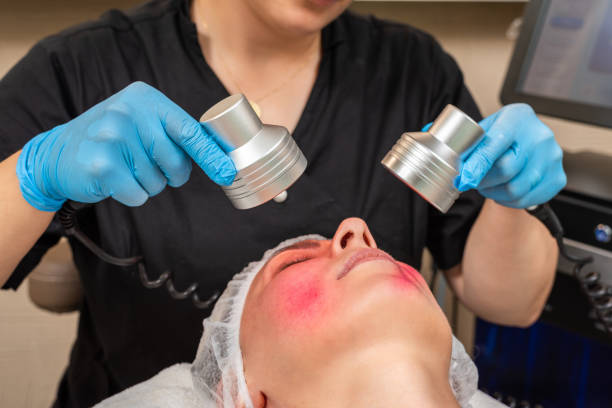For the best at-home light therapy for rosacea, I recommend devices like PlatinumLED BioMax or Mito Red MitoPRO X. Studies show red and near-infrared light effectively reduce inflammation and promote healing. These devices are convenient, non-intrusive, and cost-effective. Incorporating consistent sessions can greatly enhance symptoms by targeting bacteria and stimulating collagen production. Always consult a dermatologist before starting, as personalized advice guarantees the best results. Continue for device comparisons and usage tips to make informed decisions.
Understanding Rosacea and Light Therapy
Rosacea, a persistent inflammatory skin issue, appears in various forms and often responds well to light therapy interventions. The four primary types of rosacea include erythematotelangiectatic, papulopustular, phymatous, and ocular forms. Each type presents distinct symptoms, such as persistent redness, visible blood vessels, and ocular irritation. While the exact cause remains mysterious, it’s believed to involve a complex interplay of genetic, vascular, and environmental factors, potentially worsened by gut and nervous system issues.
Light therapy, especially red and infrared light, has emerged as a promising intervention for managing rosacea symptoms. This approach utilizes specific wavelengths of light to penetrate the skin, reducing inflammation and promoting healing. Studies have shown that pulsed dye lasers can yield remarkable improvements, although red light therapy also shows effectiveness, particularly in reducing flushing and diffuse redness. The precise mechanisms remain a subject of ongoing research, but the anti-inflammatory effects and improved blood vessel function are well-documented.
Different light colors can have varying impacts on rosacea. Red and yellow light therapies are particularly remarkable. Red light helps alleviate inflammation and repair damaged skin, while yellow light shows promise in reducing inflammation when combined with near-infrared light. Blue light, although less researched for rosacea, has shown some positive effects in preliminary studies.
It’s essential to recognize that while light therapy offers significant benefits, it should be integrated into a comprehensive treatment plan. This includes lifestyle modifications and avoidance of known triggers such as alcohol, spicy foods, and extreme temperatures. By understanding the types and root causes of rosacea, one can better appreciate the potential of light therapy as a valuable tool in managing this persistent condition.
Benefits of At-Home Light Therapy
At-home light therapy provides a convenient and efficient way to manage rosacea symptoms while reducing visits to a healthcare facility. This method enables individuals to integrate treatment into their daily schedule, resulting in consistent and lasting benefits.
Studies have indicated that red and near-infrared light therapy can greatly diminish inflammation, redness, and visible blood vessels linked to rosacea. By focusing on the dermal blood vessels and lessening the inflammatory reaction, these wavelengths aid in easing the persistent erythema and flushing that characterize the condition. This makes at-home light therapy particularly advantageous for those with erythematotelangiectatic and papulopustular forms of rosacea.
One of the key benefits of at-home light therapy is its non-intrusive nature. Unlike certain other treatments, it does not involve medications that may have widespread side effects or lead to interactions with other drugs. This is especially crucial for patients with multiple health concerns who require to manage their condition without additional complications.
Furthermore, the adaptability of at-home treatment allows for personalized care. Users can modify the frequency and duration of therapy based on their specific symptoms and response to treatment. This personalized approach can result in more effective management of rosacea over time.
From a cost perspective, investing in a quality at-home light therapy device can be more cost-effective in the long term compared to repeated clinical visits. Devices like the PlatinumLED BioMax and Mito Red MitoPRO X offer various wavelength combinations, ensuring thorough coverage of the therapeutic spectrum needed for rosacea.
Comparing Light Therapy Colors
Understanding the different colors of light therapy and their specific impacts on rosacea is crucial for tailoring the most effective at-home treatment approach. Each color of light offers unique benefits and potential drawbacks. Red light therapy, for example, has garnered significant attention due to its anti-inflammatory properties and ability to enhance skin barrier function. It’s particularly effective in reducing flushing, diffuse redness, and visible blood vessels, making it a popular choice for rosacea sufferers.
Yellow light therapy, conversely, shows promise in reducing inflammation. Although most evidence comes from animal studies, some clinical applications suggest it can alleviate the redness and irritation associated with rosacea. When combined with near-infrared light, yellow light therapy may offer even more pronounced anti-inflammatory effects.
Blue light therapy, while limited in research, appears to target the bacteria that can worsen rosacea symptoms. Some studies indicate positive outcomes, though further research is needed to confirm these initial findings. Blue light’s ability to penetrate the skin less deeply than red or yellow light makes it less effective for deeper inflammation but beneficial for surface-level issues.
- Red Light Therapy: Effective for reducing flushing, diffuse redness, and visible blood vessels.
- Yellow Light Therapy: Promising in reducing inflammation, especially when combined with near-infrared light.
- Blue Light Therapy: Targets bacteria that can worsen rosacea, though research is limited.
Combining these therapies might provide a thorough approach to managing rosacea. However, selecting the appropriate light color should be based on individual symptoms and the specific type of rosacea. Always consult with a healthcare provider to confirm that the chosen therapy aligns with your condition and overall treatment plan.
Top At-Home Light Therapy Devices
Selecting the right at-home light therapy device can make a significant difference in managing rosacea symptoms effectively. Among the top choices, the PlatinumLED BioMax stands out for its versatility. This device offers a combination of red and near-infrared light, which has shown promise in reducing inflammation and improving skin texture. The BioMax series allows for adjustable settings, making it easy to tailor treatments based on individual needs.
Another excellent option is the Mito Red MitoPRO X. This device also combines red and near-infrared wavelengths, but it includes more advanced features like pulsed and continuous modes for enhanced therapeutic outcomes. Studies have highlighted the benefits of these wavelengths in reducing redness and visible blood vessels, making the MitoPRO X a robust choice for those dealing with more severe rosacea symptoms.
For those seeking a more all-encompassing approach, the LightpathLED Diesel series offers multiple wavelength combinations, including red, blue, and yellow light. This can be particularly beneficial given the varied effects different light colors can have on rosacea. Red light helps with reducing redness, blue light has antibacterial properties, and yellow light can aid in reducing inflammation. The Diesel series provides a holistic approach, addressing multiple aspects of rosacea simultaneously.
Lastly, light therapy masks like the CurrentBody Skin LED Light Therapy Mask offer convenience and targeted treatment. These masks typically focus on red and near-infrared light, providing a straightforward way to incorporate light therapy into your skincare routine.
Tips for Effective Light Therapy Use
When incorporating light therapy into your rosacea management routine, it is crucial to follow specific guidelines to maximize effectiveness and minimize potential side effects. Based on clinical evidence and expert recommendations, here are some vital tips for using light therapy at home.
First, consistency is key. For light therapy to be effective, you need to use it regularly. Aim for daily sessions, especially in the initial phase of treatment, to see noticeable improvements. Typically, you should start noticing changes within a few weeks.
Second, always adhere to the recommended usage time. Overexposure can lead to skin irritation or exacerbate rosacea symptoms. Most devices come with manufacturer guidelines, usually recommending sessions of 10-20 minutes. Stick to these to make sure you’re receiving the benefits without any adverse effects.
Third, make sure your skin is clean and free of makeup or any topical treatments before starting your light therapy session. This guarantees that the light can penetrate your skin effectively without any barriers.
Here are three key tips to remember:
- Consistency: Utilize your device daily to observe significant improvements.
- Timing: Observe the manufacturer’s recommended session durations.
- Preparation: Always begin with clean, makeup-free skin.
Furthermore, consult your dermatologist before starting any light therapy regimen. They can provide personalized advice and help monitor your progress. If you encounter any adverse reactions, discontinue use immediately and seek medical advice. Combining light therapy with other treatments, such as topical medications, may also improve your results, but this should be done under professional guidance.
Conclusion
In my journey with rosacea, discovering at-home light therapy has been transformative. By understanding the benefits and nuances of different light wavelengths, I’ve found personalized treatments that markedly reduce redness and inflammation. The key is consistency and choosing the right device for your needs. With the right at-home light therapy solution, managing rosacea is more achievable than ever. Don’t hesitate to explore these options—relief might be just a light away.




